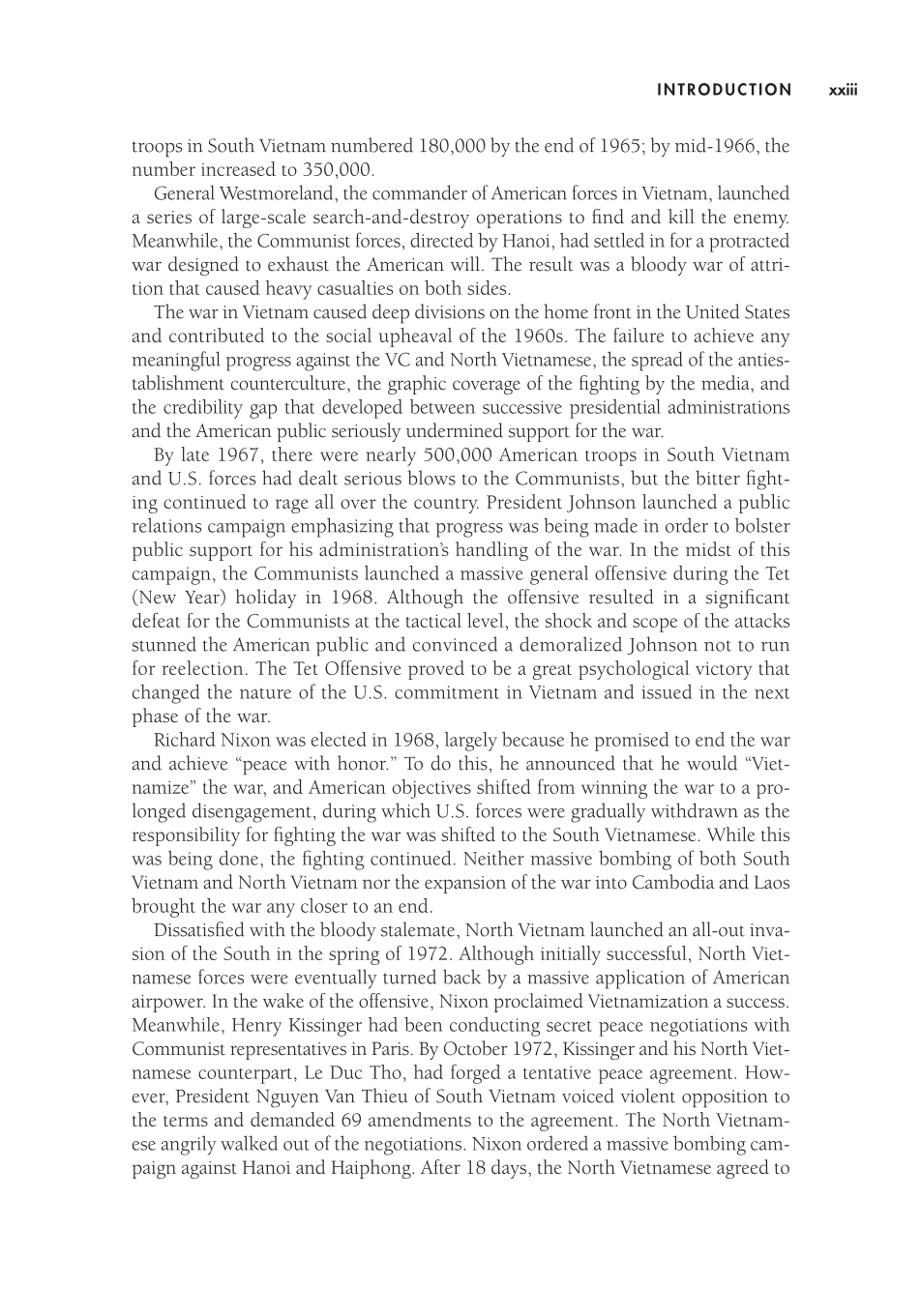I ntroduction xxiii
troops in South Vietnam numbered 180,000 by the end of 1965; by mid-1966, the
number increased to 350,000.
General Westmoreland, the commander of American forces in Vietnam, launched
a series of large-scale search-and-destroy operations to find and kill the enemy.
Meanwhile, the Communist forces, directed by Hanoi, had settled in for a protracted
war designed to exhaust the American will. The result was a bloody war of attri-
tion that caused heavy casualties on both sides.
The war in Vietnam caused deep divisions on the home front in the United States
and contributed to the social upheaval of the 1960s. The failure to achieve any
meaningful progress against the VC and North Vietnamese, the spread of the anties-
tablishment counterculture, the graphic coverage of the fighting by the media, and
the credibility gap that developed between successive presidential administrations
and the American public seriously undermined support for the war.
By late 1967, there were nearly 500,000 American troops in South Vietnam
and U.S. forces had dealt serious blows to the Communists, but the bitter fight-
ing continued to rage all over the country. President Johnson launched a public
relations campaign emphasizing that progress was being made in order to bolster
public support for his administration’s handling of the war. In the midst of this
campaign, the Communists launched a massive general offensive during the Tet
(New Year) holiday in 1968. Although the offensive resulted in a significant
defeat for the Communists at the tactical level, the shock and scope of the attacks
stunned the American public and convinced a demoralized Johnson not to run
for reelection. The Tet Offensive proved to be a great psychological victory that
changed the nature of the U.S. commitment in Vietnam and issued in the next
phase of the war.
Richard Nixon was elected in 1968, largely because he promised to end the war
and achieve “peace with honor.” To do this, he announced that he would “Viet-
namize” the war, and American objectives shifted from winning the war to a pro-
longed disengagement, during which U.S. forces were gradually withdrawn as the
responsibility for fighting the war was shifted to the South Vietnamese. While this
was being done, the fighting continued. Neither massive bombing of both South
Vietnam and North Vietnam nor the expansion of the war into Cambodia and Laos
brought the war any closer to an end.
Dissatisfied with the bloody stalemate, North Vietnam launched an all-out inva-
sion of the South in the spring of 1972. Although initially successful, North Viet
namese forces were eventually turned back by a massive application of American
airpower. In the wake of the offensive, Nixon proclaimed Vietnamization a success.
Meanwhile, Henry Kissinger had been conducting secret peace negotiations with
Communist representatives in Paris. By October 1972, Kissinger and his North Viet
namese counterpart, Le Duc Tho, had forged a tentative peace agreement. How-
ever, President Nguyen Van Thieu of South Vietnam voiced violent opposition to
the terms and demanded 69 amendments to the agreement. The North Vietnam
ese angrily walked out of the negotiations. Nixon ordered a massive bombing cam-
paign against Hanoi and Haiphong. After 18 days, the North Vietnamese agreed to





















































































































































































































































































































































































































































































































































































































































































































































































































































































